Selina Concise Biology Class 10 ICSE Solutions Chapter 7 - The Excretory System (Elimination of Body Wastes)
Selina Concise Biology Class 10 ICSE Solutions The Excretory System (Elimination of Body Wastes)
Selina Concise Biology Class 10 ICSE Solutions The Excretory System (Elimination of Body Wastes)
Exercise 7
A.1.Excretion primarily involves
(a) Removal of all byproducts during catabolism
(b) Removal of byproducts during anabolism
(c) Removal of nitrogenous wastes
(d) Throwing out excess of water
(a) Removal of all byproducts during catabolism
(b) Removal of byproducts during anabolism
(c) Removal of nitrogenous wastes
(d) Throwing out excess of water
(c) Removal of nitrogenous wastes
A.2.Maximum amount of water from the glomerular filtrate is reabsorbed in
(a) Proximal convoluted tubule
(b) Descending limb of loop of Henle
(c) Ascending limb of loop of Henle
(d) Distal convoluted tubule
Solution A.2.
(a) Proximal convoluted tubule
A.3.Which one of the following in real sense is not an excretory activity?
(a) Giving out carbon dioxide
(b) Passing out faecal matter
(c) Sweating
(d) Removal of urea
Solution A.3.
(c) Sweating
A.4.In humans, urea is formed in
(a) Ureter
(b) Liver
(c) Spleen
(d) kidney
Solution A.4.
Liver
B.1.Name the following:
(a) The organ which produces urea.
(b) The outer region of kidney containing the Bowman's capsule.
(c) The tuft of capillaries inside the Bowman's capsule.
(d) The part of kidney tubules where the term urine is first used for the fluid in it.
(e) The vein in which urea concentration is maximum.
Solution B.1.
(a) Liver
(b) Cortex
(c) Glomerulus
(d) Collecting duct
(e) Renal artery (Renal vein has urea but renal artery has higher concentration of urea as compared to renal vein).
B.2.Given below are two sets (a and b) of five terms each. Rewrite the terms in their correct order so as to be in logical sequence.
(a) Afferent arteriole, renal vein, capillary network, glomerulus, efferent arteriole
(b) Renal artery, urethra, ureter, kidney, urinary bladder
Solution B.2.
(a) Afferent arteriole, glomerulus, efferent arteriole, capillary network, renal vein
(b) Renal artery, kidney, ureter, urinary bladder, urethra
B.3.In each of the following sets of body parts/substances/processes, pick out the one item which overall includes the remaining four
(a) Glomerular filtrate, Bowman's capsule, ultrafiltration, glomerulus, blood plasma.
(b) Skin, liver, lungs, kidneys, excretion.
(c) ADH, water, pituitary, osmoregulation, urine.
(d) CO2, bile pigments, water, excretion, urea.
Solution B.3.
(a) Ultrafiltration
(b) Excretion
(c) Osmoregulation
(d) Excretion
C.1.Write down the functional activity of the following parts:
(a) Glomerulus
(b) Henle's loop
(c) Ureter
(d) Renal artery
(e) Urethra
Solution C.1.
(a) Glomerulus is involved in the process of ultrafiltration.The liquid part of the blood which is plasma including urea, salts, glucose filters out from the glomerulus into the renal tubule.
(b) Henle’s loop is involved in reabsorption of water and sodium ions.
(c) Ureter carries urine to the urinary bladder by ureteral peristalsis.
(d) Renal artery supplied blood to the kidney.
(e) Urethra is involved in the process of micturition i.e. expelling urine out of the body.
C.2.Why is excretion necessary? Name the common excretory substances in our body.
Solution C.2.
Excretion helps in removing toxic wastes from our body and it also plays an important role osmoregulation i.e. the maintenance of the homeostasis of the body.
Carbon dioxide, water, nitrogenous compounds such as urea, uric acid and excess salts are some common excretory products.
C.3.What is a uriniferous tubule? How does it function?
C.3.What is a uriniferous tubule? How does it function?
Solution C.3.
A uriniferous tubule also known as the kidney tubule is the structural and functional unit of the kidney.
It takes in impure blood from the renal artery and removes wastes in the form of urine. It also provides a larger surface area for reabsorption of salts and water.
C.4.Why is it necessary to maintain a normal osmotic concentration of the blood?
C.4.Why is it necessary to maintain a normal osmotic concentration of the blood?
Solution C.4.
Maintaining a normal osmotic concentration in the body means regulating the percentage of water and salts. If this regulation mechanism fails we either end up losing vital salts and water or may accumulate unwanted salts and excess water in our body.
C.5.If you donate one kidney to a needy patient, would it cause any harm to you? Give reason.
C.5.If you donate one kidney to a needy patient, would it cause any harm to you? Give reason.
Solution C.5.
If one kidney is donated to a needy patient, the other kidney alone is sufficient for removing wastes or excretion. Thus, the donor can live a normal life.
C.6.In summer the urine is slightly thicker than in winter. Explain the reason.
C.6.In summer the urine is slightly thicker than in winter. Explain the reason.
Solution C.6.
During summer, a considerable part of water is lost through perspiration so the kidneys have to reabsorb more water from the urine. This makes the urine thicker in summer than in winters.
C.7.Differentiate between the following pairs of terms:
(a) Bowman's capsule and malpighian capsule
(b) Renal cortex and renal medulla
(c) Renal pelvis and renal papilla
(d) Urea and urine
(e) Excretion and catabolism
C.7.Differentiate between the following pairs of terms:
(a) Bowman's capsule and malpighian capsule
(b) Renal cortex and renal medulla
(c) Renal pelvis and renal papilla
(d) Urea and urine
(e) Excretion and catabolism
Solution C.7.
(a) Bowman’s capsule is a thin walled cup containing the glomerulus. This Bowman’s capsule along with the glomerulus is known as malpighian capsule.
(b) The renal cortex is the outer darker region of the kidney whereas the renal medulla is the inner lighter region of the kidney.
(c) Renal pelvis is the expanded front end of the ureter in the kidney whereas the renal papilla is the apex of the renal pyramid which projects into the pelvis.
(d) Urea is the chief excretory product which is excreted in the form of urine whereas urine is the filtrate left after reabsorption and tubular secretion which contains 95% water and 5% solid wastes.
(e) Excretion is the process of removal of chemical wastes especially nitrogenous wastes from the body.
Catabolism on the other hand is the set of metabolic pathways which break down molecules into smaller units and release energy.
C.8.Name the main nitrogenous metabolic waste excreted out by mammals including humans.
C.8.Name the main nitrogenous metabolic waste excreted out by mammals including humans.
Solution C.8.
Urea, creatinine, uric acid
C.9.Match the items in Column I with those in Column II and write down the matching pairs.
Column I
|
Column II
|
(a) Bowman's Capsule
|
(i) Renal artery
|
(b) Contains more CO2 and less urea
|
(ii) Regulates amount of water excreted
|
(c) Anti-diuretic hormone
|
(iii) Renal vein
|
(d) Contains more urea
|
(iv) Glomerulus
|
Solution C.9.
C.10.Fill in the blanks in the following passage to make it a meaningful description.
In a nephron, the _______ flows through the ________ under great pressure. The reason for this great pressure is that the ________ (outgoing) _________ is narrower than the __________ (incoming). This high pressure causes the _______ part of the blood to filter out from the ________ into the _______ capsule.
Solution C.10.
In a nephron, the blood flows through the glomerulus under great pressure. The reason for this great pressure is that the efferent (outgoing) arteriole is narrower than the afferent arteriole (incoming). This high pressure causes the liquid part of the blood to filter out from the glomerulusinto the renal capsule.
D.1.Define the following terms:
(a) Ultrafiltration
(b) Micturition
(c) Renal pelvis
(d) Urea
(e) Osmoregulation
D.1.Define the following terms:
(a) Ultrafiltration
(b) Micturition
(c) Renal pelvis
(d) Urea
(e) Osmoregulation
Solution D.1.
(a) Ultrafiltration – The process of the filtration of blood in the glomerulus under great pressure during which the liquid part of the blood i.e. plasma along with urea, glucose, amino acids and other substances enter the renal tubule.
(b) Micturition – The process of expelling urine out of the body through urethra by opening the sphincter muscles passing of urine involving relaxation of sphincter muscles between the urinary bladder and urethra.
(c) Renal pelvis – Renal pelvis is the expanded front end of the ureters into the kidney.
(d) Urea – A nitrogenous waste produced primarily in the liver due to the break down dead protein remains and extra amino acids.
(e) Osmoregulation – It is a process of maintaining the blood composition of the body i.e. the normal osmotic concentration of water and salts in the body.
D.2.Explain the terms ultrafiltration and selective absorption.
Solution D.2.
Ultrafiltration – Ultrafiltration involves filtration of the blood which takes place in the glomerulus. The blood containing urea from the afferent arteriole enters the glomerulus under high pressure. The high pressure is created because the efferent arteriole is narrower than the afferent arteriole. The high pressure causes the liquid part of the blood to filter out from the glomerulus into the renal tubule. This filtrate is known as ‘glomerular filtrate’.
Glomerular filtrate consists of water, urea, salts, glucose and other plasma solutes. Blood corpuscles, proteins and other large molecules remain behind in the glomerulus. Therefore the blood which is carried away by the efferent arteriole is relatively thick.
Selective absorption – The Glomerular filtrate entering the renal tubule contains a lot of usable materials such as glucose and sodium. As this filtrate passes down the renal tubule, a lot of water along with these usable materials is reabsorbed. Such reabsorption is called ‘selective absorption’. The reabsorption occurs only to the extent that the normal concentration of the blood is undisturbed.
D.3.What is dialysis? Under what conditions is it carried out?
Solution D.3.
Dialysis involves the use of artificial kidney or a dialysis machine. The patient’s blood is from the radial artery is led through the machine where excess salts and urea is removed. The purified blood is then returned to a vein in the same arm.
Dialysis is carried out in case of failure of both the kidneys. In case there is a permanent damage, then the dialysis is to be repeated for about 12 hours twice a week.
E.1.Look at the figure given below. It is a section of human kidney as seen from the front.
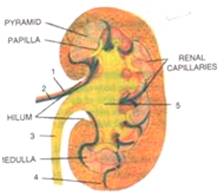
(a) Is it a longitudinal section or a cross-section?
(b) Name the parts numbered 1-5.
(c) Which area/part (give its name and number given on the diagram) which contains the following:
(i) Malpighian capsule
(ii) The pyramids
(iii) Freshly collected urine
Solution E.1.
(a) It is a longitudinal section of the kidney.
(b) 1-renal artery, 2-renal vein, 3-ureter, 4-cortex, 5-pelvis
(c) (i) 4/cortex
(ii) medulla
(iii) 5/pelvis
E.2.Given below is the figure of certain organs and associated parts in the human body. Study the same and answer the questions that follow:
(a) Name all the organ-systems shown completely or even partially.
(b) Name the parts numbered 1 to 5.
(c) Name the structural and functional unit of the part marked '1'.
(d) Name the two main organic constituents of the fluid that flows down the part labeled '3'.
(e) Name the two major steps involved in the formation of the fluid that passes down the part labeled '3'.
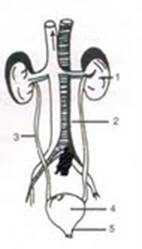
Solution E.2.
(a) Excretory system and Circulatory system.
(b) 1-kidney, 2-renal artery, 3-ureter, 4-urinary bladder, 5-urethera
(c) Nephron
(d) Urea and ammonia
(e) Ultrafiltration and selective reabsorption
E.3.The following diagram represents a mammalian kidney tubule (nephron) and its blood supply.
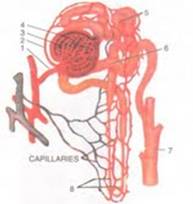
Parts indicated by the guidelines 1to 8 are as follows:
1. Afferent arteriole from renal artery
2. Efferent arteriole
3. Bowman's capsule
4. Glomerulus
5. Proximal convoluted tubule with blood capillaries
6. Distal convoluted tubule with blood capillaries
7. Collecting tubule
8. U-shaped loop of Henle
Study the diagram and answer the questions that follow:
(a) Where does ultrafiltration take place?
(b) Which structure contains the lowest concentration of urea?
(c) Which structure contains the highest concentration of urea?
(d) Which structure (normally) contains the lowest concentration of glucose?
(e) Where is most water reabsorbed?
Solution E.3.
(a) 4/Glomerulus
(b) 2/Efferent arteriole
(c) 1/ Afferent arteriole from renal artery
(d) 7/Collecting tubule
(e) 5/ Proximal convoluted tubule with blood capillaries
E.4.Given below is a highly simplified diagram of the human kidney cut open longitudinally. Answer the questions that follow:
(a) Define excretion.
(b) Name the functional units of the kidneys.
(c) Why does the cortex of the kidney show a dotted appearance?
(d) Mention two functions of the kidney.
(e) Write two differences in composition of the blood flowing through the blood vessels, 'A' and 'B'.
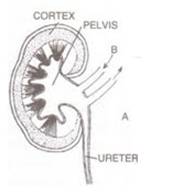
Solution E.4.
(a) The process of removal of chemical wastes especially nitrogenous waste from the body is known as excretion.
(b) Nephrons
(c) As the cortex region contains numerous nephrons or kidney tubules, therefore, it shows a dotted appearance.
(d) Kidneys help in removing wastes or excretion and osmoregulation.(e) The blood vessel ‘B’ is renal artery and the blood vessel ‘A’ is renal vein.
So the blood vessel ‘B’ contains oxygenated blood with high concentration of urea and glucose whereas the blood vessel ‘A’ contains deoxygenated blood with low concentration of urea and glucose as compared to renal artery.
E.5.Study the diagram given alongside and then answer the questions that follow:
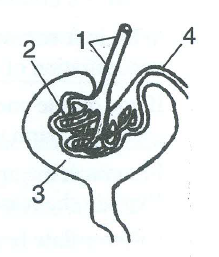
a. Name the region in the kidney where the above structure is present?
b. Name the parts labelled 1, 2, 3, and 4.
c. Name the stages involved in the formation of urine.
d. What is the technical term given to the process occurring in 2 and 3? Briefly describe the process.
Solution E.5.
a. The structure is a Bowman’s capsule, which is part of the nephron. The Bowman’s capsule is found in the cortex of the kidney.
b.
- Afferent arteriole
- Glomerulus
- Bowman’s capsule
- Efferent arteriole
c. Urine formation occurs in two steps – ultrafiltration and reabsorption.
d. The process occurring in 2 and 3 is known as ultrafiltration.
In the glomerulus, the blood flows under high pressure because of the narrow lumen of the capillary network of the glomerulus. This forces most of the components (both waste and useable materials) of the blood out of the capillaries. This process of the filtration of blood under high pressure in the Bowman’s capsule is known as ultrafiltration.
